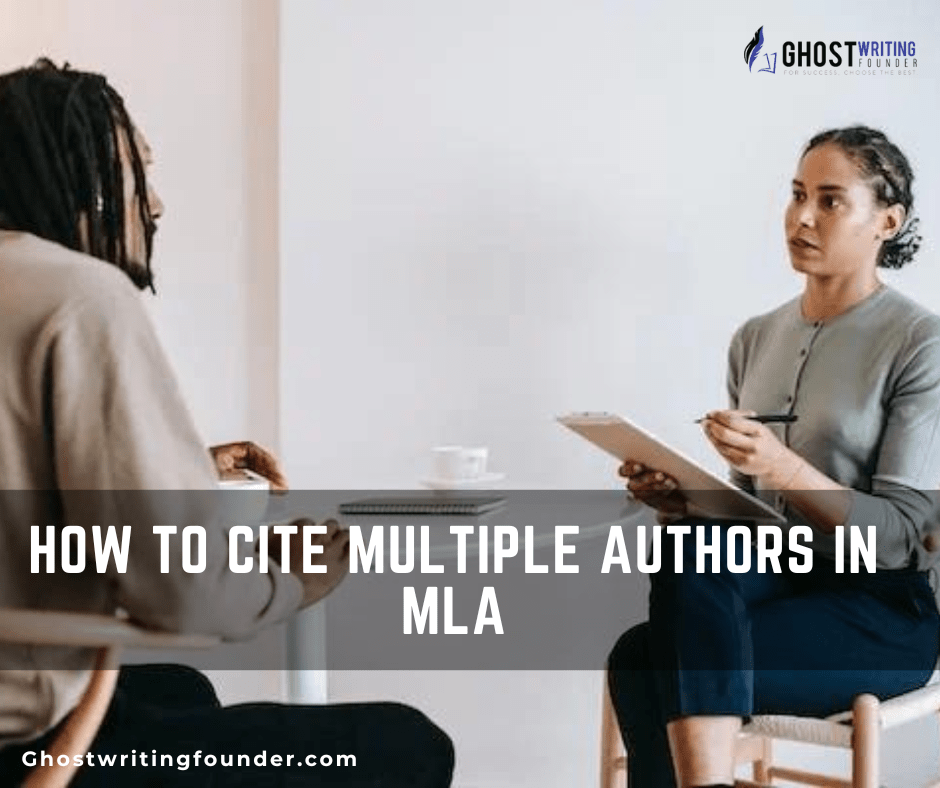
Authors Writing
Introduction
In this guide, the ghostwriting founder will walk you through how to Cite Multiple Authors in MLA format. First, we’ll look at a basic example of citing an article with multiple authors using the updated eighth-edition MLA guidelines, similar to the detailed steps found in our Complete Book Tropes List. Then we’ll dive into each step to Cite Multiple Authors in more detail.
Cite Multiple Authors: Cite a book with two authors
You must include both names when you Cite Multiple Authors collectively around two authors. If the publisher has provided them, use their initials instead of their first and middle names. For example:
- “Smith, Jane A.” (the name of one author)
- “Smith and Jones” (the names of both authors)
Cite Multiple Authors: Cite a book with three or more authors.
Here is how you can Cite Multiple Authors collectively around three or more.
- First, name the book, followed by a period.
- Next, list all the authors’ names in order of their appearance on the title page, separated by commas. If no author is listed for this work, use “Anonymous” instead.
- Reference page number(s) from your text where you found this information (you may also need to look at endnotes).
If you’re citing an e-book or digital copy of a print book, include that information in parentheses after each citation, much like the guidance provided in our E-book Distribution Strategies. and any other necessary details (i.e., “Online at…”). If you have multiple reference page numbers, separate them with commas.
Citing a book with an editor and author or authors.
When you Cite Multiple Authors and are citing a book with an editor and author or authors, you need to list the editor’s name first, followed by the author(s). If there are multiple editors, list them in alphabetical order. If there are multiple authors, list them in alphabetical order.
In this case, if your book has both an editor and an author who aren’t separate entities (like “Edited by Jane Smith”), put the editor’s name first:
- “Edited by Jane Smith” or “Edited by Jane Smith and John Doe”. If you’re citing a book with an editor and author who aren’t separate entities, put the editor’s name first: “Jane Smith (editor)”.
Citing an article without the author’s name at the end of the sentence.
The author’s name is not in the sentence, so that you will use a parenthetical citation.
In this case, you should include only one author’s last name in your parenthetical citation and place it after the year of publication (or page number). The rest of your citations will be as follows:
- Author’s Last Name
- First Name.
- “Title of Article.
- ” Title of Journal or Magazine Volume Number(Issue)
- Page Numbers to be cited for the article
Citing an article with one author’s name at the end of the sentence:
Citing an article with one author’s name at the end of the sentence and another in parenthesis after the period.
- The first author’s last name is “Author,” followed by their first name (if applicable).
- You then write “and” before listing any other authors’ names. The second author’s last name should be written as it would normally appear on its line: without quotation marks or italics, followed by a comma.
For example, if two people wrote this paper together but had different last names– Smith and Jones–you would write: Author1andAuthor2.
When you Cite Multiple Authors, then The last name of the first author should be italicized, as discussed in our blog on How to Publish a Book. and the second author should not be. After a comma, write “et al.” to indicate more co-authors than just those listed above. If you’re citing a book with three or more authors, list them by last name in order of appearance on the cover page: Author1, Author2 and Author3
Citing an article with two or more names at the end of the sentence:
To cite an article with two or more authors, place the first author’s name in parentheses after a period and then add a comma.
The second author’s name should be followed by a period (if there is one).
If there is a third author, place their name in parentheses after the second author’s last name and add another comma before typing out their last name.
The same rules apply when citing multiple works by one author: place all names in parentheses after punctuating with periods as needed for each entry.
For example:
Smith, John (2009). “The Nature of the Thing.” In Q. Jones, Editor. The Philosophy of X. New York: Oxford University Press.
Multiple Sources by the Same Author
Sometimes, you might be using multiple sources written by the same author and don’t need to Cite Multiple Authors, which is a scenario we explore in our article about Bookstagram Hashtags. In such cases, you must distinguish between these sources in your in-text citations and Works Cited page. You can use a short title or a keyword from the source’s title to differentiate them.
In your in-text citation
Include the author’s last name and a shortened version of the title. For instance, if you’re citing two sources by John Anderson, “The Science of Stars” and “Exploring Planets,” your citations could look like this: (Anderson, “Stars” 15) and (Anderson, “Planets” 28).
In the Works Cited page, provide the full titles of the sources along with the rest of the publication details:
- Anderson, John. “The Science of Stars.” Astronomy Today, vol. 14, no. 1, 2021, pp. 10-25.
- “Exploring Planets.” Space Discoveries, vol. 5, no. 3, 2022, pp. 26-40.
Online Sources
In today’s digital age, you might use online sources such as websites, articles, autobiography writing services or blog posts. Citing these sources follows the same principles as citing printed materials. Just make sure to include the website’s name, the URL, and the date you accessed the information.
Here’s an example of citing an online article
Johnson, Emily, and Mark Davis. “Climate Change and Our Oceans.” Environmental Insights, www.environmentalinsights.org/climate-oceans, Accessed 8 August 2023.
Essential Elements and Detailed Insights
| Step | Details | Additional Notes |
|---|---|---|
| Cite a Book With Two Authors | Include both names, use initials if provided. | For example: “Smith, Jane A.” and “Smith and Jones”. |
| Cite a Book With Three or More Authors | List all authors in order, use “Anonymous” if no author listed. | Include page numbers, e-book details if applicable. |
| Citing A Book With An Editor And Author Or Authors | List editor’s name first, then authors in alphabetical order. | If editor and author are the same entity, list editor first. |
| Citing An Article Without The Author’s Name | Use parenthetical citation with the author’s last name. | Include year of publication or page number. |
| Citing An Article With One Author’s Name | Place the author’s last name and first name. | Follow with “and” before listing other authors’ names. |
| Citing An Article With Two Or More Names | Place the first author’s name in parentheses, followed by others. | Apply periods and commas as needed for multiple authors. |
| Multiple Sources By The Same Author | Distinguish sources with a short title or keyword. | For in-text citations and Works Cited page, use varied titles. |
Conclusion
Hopefully, you now better understand how to cite multiple authors in MLA. This can be a tricky process, but it’s not impossible! With these 10 steps and the tips we’ve given above, you should be able to easily Cite Multiple Authors.
Citing multiple authors in MLA style might seem tricky initially, but with practice and attention to detail, you’ll become a pro in no time. Remember to properly format your in-text citations, use “et al.” when there are three or more authors, and correctly arrange the authors’ names on your Works Cited page. Citing your sources not only strengthens your work but also contributes to the scholarly community, as we discuss in our piece on The Importance of Copyright and Intellectual Property. by acknowledging the contributions of others. So, as you embark on your research journey, keep these citation rules in mind to confidently navigate the world of academic writing, and for further guidance, our Book Editing Services can ensure your citations are flawless.









Leave a Reply